为网友们分享了相关的编程文章,网友方坚秉根据主题投稿了本篇教程内容,涉及到Java NIO三大组件、Java ByteBuffer、Java NIO三大组件相关内容,已被315网友关注,下面的电子资料对本篇知识点有更加详尽的解释。
Java NIO三大组件
1、三大组件
1.1 Channel & Buffer
channel 有一点类似于 stream,它就是读写数据的双向通道,可以从 channel 将数据读入 buffer,也可以将 buffer 的数据写入 channel,而之前的 stream 要么是输入,要么是输出,channel 比 stream 更为底层

常见的 Channel 有
- FileChannel
- DatagramChannel
- SocketChannel
- ServerSocketChannel
buffer 则用来缓冲读写数据,常见的 buffer 有
- ByteBuffer
- MappedByteBuffer
- DirectByteBuffer
- HeapByteBuffer
- ShortBuffer
- IntBuffer
- LongBuffer
- FloatBuffer
- DoubleBuffer
- CharBuffer
1.2 Selector
selector 单从字面意思不好理解,需要结合服务器的设计演化来理解它的用途
多线程版设计
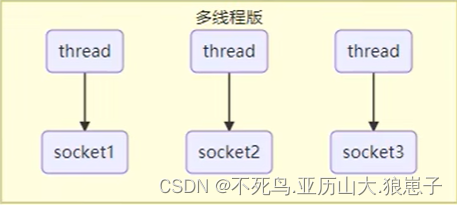
多线程版缺点
- 内存占用高
- 线程上下文切换成本高
- 只适合连接数少的场景
线程池版设计
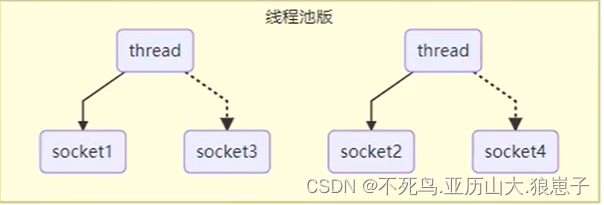
线程池版缺点
- 阻塞模式下,线程仅能处理一个 socket 连接
- 仅适合短连接场景
selector 版设计
selector 的作用就是配合一个线程来管理多个 channel,获取这些 channel 上发生的事件,这些 channel 工作在非阻塞模式下,不会让线程吊死在一个 channel 上。适合连接数特别多,但流量低的场景(low traffic)
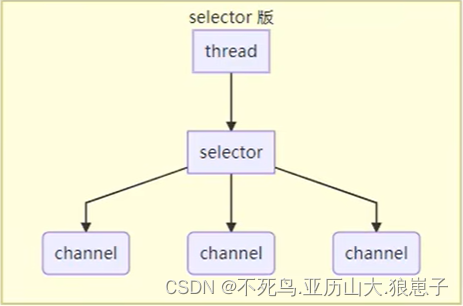
调用 selector 的 select() 会阻塞直到 channel 发生了读写就绪事件,这些事件发生,select 方法就会返回这些事件交给 thread 来处理
2、ByteBuffer
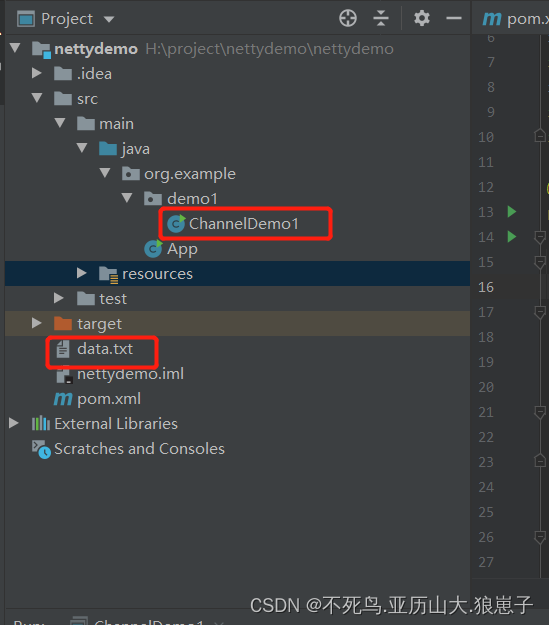
有一普通文本文件 data.txt,内容为
1234567890abcd
使用 FileChannel 来读取文件内容
package org.example.demo1;
import lombok.extern.slf4j.Slf4j;
import java.io.FileInputStream;
import java.io.FileNotFoundException;
import java.io.IOException;
import java.io.RandomAccessFile;
import java.nio.ByteBuffer;
import java.nio.channels.FileChannel;
@Slf4j
public class ChannelDemo1 {
public static void main(String[] args) {
try (FileChannel channel = new FileInputStream("data.txt").getChannel()) {
ByteBuffer buffer = ByteBuffer.allocate(10);
do {
// 向 buffer 写入
int len = channel.read(buffer);
log.debug("读到字节数:{}", len);
if (len == -1) {
break;
}
// 切换 buffer 读模式
buffer.flip();
while(buffer.hasRemaining()) {
byte b = buffer.get();
log.debug("实际字节{}", (char)b);
}
// 切换 buffer 写模式
buffer.clear();
} while (true);
} catch (IOException e) {
e.printStackTrace();
}
}
}输出
15:03:39.467 [main] DEBUG org.example.demo1.ChannelDemo1 - 读到字节数:10
15:03:39.475 [main] DEBUG org.example.demo1.ChannelDemo1 - 实际字节1
15:03:39.475 [main] DEBUG org.example.demo1.ChannelDemo1 - 实际字节2
15:03:39.476 [main] DEBUG org.example.demo1.ChannelDemo1 - 实际字节3
15:03:39.476 [main] DEBUG org.example.demo1.ChannelDemo1 - 实际字节4
15:03:39.476 [main] DEBUG org.example.demo1.ChannelDemo1 - 实际字节5
15:03:39.476 [main] DEBUG org.example.demo1.ChannelDemo1 - 实际字节6
15:03:39.476 [main] DEBUG org.example.demo1.ChannelDemo1 - 实际字节7
15:03:39.476 [main] DEBUG org.example.demo1.ChannelDemo1 - 实际字节8
15:03:39.476 [main] DEBUG org.example.demo1.ChannelDemo1 - 实际字节9
15:03:39.476 [main] DEBUG org.example.demo1.ChannelDemo1 - 实际字节0
15:03:39.476 [main] DEBUG org.example.demo1.ChannelDemo1 - 读到字节数:4
15:03:39.477 [main] DEBUG org.example.demo1.ChannelDemo1 - 实际字节a
15:03:39.477 [main] DEBUG org.example.demo1.ChannelDemo1 - 实际字节b
15:03:39.477 [main] DEBUG org.example.demo1.ChannelDemo1 - 实际字节c
15:03:39.477 [main] DEBUG org.example.demo1.ChannelDemo1 - 实际字节d
15:03:39.477 [main] DEBUG org.example.demo1.ChannelDemo1 - 读到字节数:-1
2.1 ByteBuffer 正确使用姿势
- 向 buffer 写入数据,例如调用 channel.read(buffer)
- 调用 flip() 切换至读模式
- 从 buffer 读取数据,例如调用 buffer.get()
- 调用 clear() 或 compact() 切换至写模式
- 重复 1~4 步骤
2.2 ByteBuffer 结构
ByteBuffer 有以下重要属性
- capacity
- position
- limit
一开始
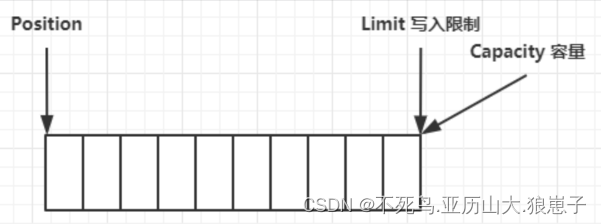
写模式下,position 是写入位置,limit 等于容量,下图表示写入了 4 个字节后的状态
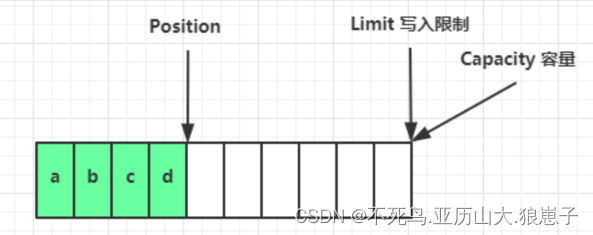
flip 动作发生后,position 切换为读取位置,limit 切换为读取限制
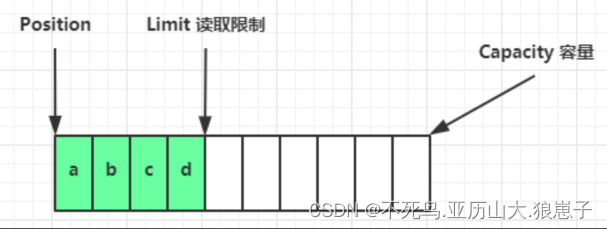
读取 4 个字节后,状态
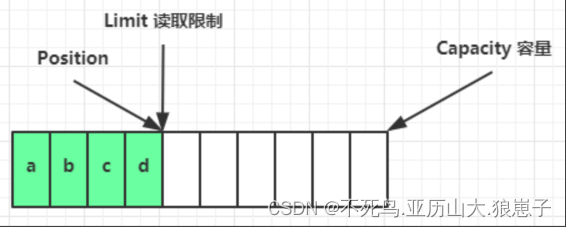
clear 动作发生后,状态
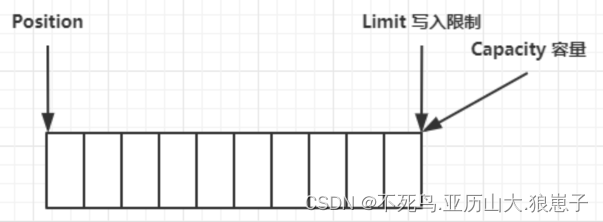
compact 方法,是把未读完的部分向前压缩,然后切换至写模式

调试工具类
package org.example.utils;
import io.netty.util.internal.StringUtil;
import java.nio.ByteBuffer;
import static io.netty.util.internal.MathUtil.isOutOfBounds;
import static io.netty.util.internal.StringUtil.NEWLINE;
public class ByteBufferUtil {
private static final char[] BYTE2CHAR = new char[256];
private static final char[] HEXDUMP_TABLE = new char[256 * 4];
private static final String[] HEXPADDING = new String[16];
private static final String[] HEXDUMP_ROWPREFIXES = new String[65536 >>> 4];
private static final String[] BYTE2HEX = new String[256];
private static final String[] BYTEPADDING = new String[16];
static {
final char[] DIGITS = "0123456789abcdef".toCharArray();
for (int i = 0; i < 256; i++) {
HEXDUMP_TABLE[i << 1] = DIGITS[i >>> 4 & 0x0F];
HEXDUMP_TABLE[(i << 1) + 1] = DIGITS[i & 0x0F];
}
int i;
// Generate the lookup table for hex dump paddings
for (i = 0; i < HEXPADDING.length; i++) {
int padding = HEXPADDING.length - i;
StringBuilder buf = new StringBuilder(padding * 3);
for (int j = 0; j < padding; j++) {
buf.append(" ");
}
HEXPADDING[i] = buf.toString();
}
// Generate the lookup table for the start-offset header in each row (up to 64KiB).
for (i = 0; i < HEXDUMP_ROWPREFIXES.length; i++) {
StringBuilder buf = new StringBuilder(12);
buf.append(NEWLINE);
buf.append(Long.toHexString(i << 4 & 0xFFFFFFFFL | 0x100000000L));
buf.setCharAt(buf.length() - 9, '|');
buf.append('|');
HEXDUMP_ROWPREFIXES[i] = buf.toString();
}
// Generate the lookup table for byte-to-hex-dump conversion
for (i = 0; i < BYTE2HEX.length; i++) {
BYTE2HEX[i] = ' ' + StringUtil.byteToHexStringPadded(i);
}
// Generate the lookup table for byte dump paddings
for (i = 0; i < BYTEPADDING.length; i++) {
int padding = BYTEPADDING.length - i;
StringBuilder buf = new StringBuilder(padding);
for (int j = 0; j < padding; j++) {
buf.append(' ');
}
BYTEPADDING[i] = buf.toString();
}
// Generate the lookup table for byte-to-char conversion
for (i = 0; i < BYTE2CHAR.length; i++) {
if (i <= 0x1f || i >= 0x7f) {
BYTE2CHAR[i] = '.';
} else {
BYTE2CHAR[i] = (char) i;
}
}
}
/**
* 打印所有内容
* @param buffer
*/
public static void debugAll(ByteBuffer buffer) {
int oldlimit = buffer.limit();
buffer.limit(buffer.capacity());
StringBuilder origin = new StringBuilder(256);
appendPrettyHexDump(origin, buffer, 0, buffer.capacity());
System.out.println("+--------+-------------------- all ------------------------+----------------+");
System.out.printf("position: [%d], limit: [%d]\n", buffer.position(), oldlimit);
System.out.println(origin);
buffer.limit(oldlimit);
}
/**
* 打印可读取内容
* @param buffer
*/
public static void debugRead(ByteBuffer buffer) {
StringBuilder builder = new StringBuilder(256);
appendPrettyHexDump(builder, buffer, buffer.position(), buffer.limit() - buffer.position());
System.out.println("+--------+-------------------- read -----------------------+----------------+");
System.out.printf("position: [%d], limit: [%d]\n", buffer.position(), buffer.limit());
System.out.println(builder);
}
private static void appendPrettyHexDump(StringBuilder dump, ByteBuffer buf, int offset, int length) {
if (isOutOfBounds(offset, length, buf.capacity())) {
throw new IndexOutOfBoundsException(
"expected: " + "0 <= offset(" + offset + ") <= offset + length(" + length + ") <= " + "buf.capacity(" + buf.capacity() + ')');
}
if (length == 0) {
return;
}
dump.append(
" +-------------------------------------------------+" +
NEWLINE + " | 0 1 2 3 4 5 6 7 8 9 a b c d e f |" +
NEWLINE + "+--------+-------------------------------------------------+----------------+");
final int startIndex = offset;
final int fullRows = length >>> 4;
final int remainder = length & 0xF;
// Dump the rows which have 16 bytes.
for (int row = 0; row < fullRows; row++) {
int rowStartIndex = (row << 4) + startIndex;
// Per-row prefix.
appendHexDumpRowPrefix(dump, row, rowStartIndex);
// Hex dump
int rowEndIndex = rowStartIndex + 16;
for (int j = rowStartIndex; j < rowEndIndex; j++) {
dump.append(BYTE2HEX[getUnsignedByte(buf, j)]);
}
dump.append(" |");
// ASCII dump
for (int j = rowStartIndex; j < rowEndIndex; j++) {
dump.append(BYTE2CHAR[getUnsignedByte(buf, j)]);
}
dump.append('|');
}
// Dump the last row which has less than 16 bytes.
if (remainder != 0) {
int rowStartIndex = (fullRows << 4) + startIndex;
appendHexDumpRowPrefix(dump, fullRows, rowStartIndex);
// Hex dump
int rowEndIndex = rowStartIndex + remainder;
for (int j = rowStartIndex; j < rowEndIndex; j++) {
dump.append(BYTE2HEX[getUnsignedByte(buf, j)]);
}
dump.append(HEXPADDING[remainder]);
dump.append(" |");
// Ascii dump
for (int j = rowStartIndex; j < rowEndIndex; j++) {
dump.append(BYTE2CHAR[getUnsignedByte(buf, j)]);
}
dump.append(BYTEPADDING[remainder]);
dump.append('|');
}
dump.append(NEWLINE +
"+--------+-------------------------------------------------+----------------+");
}
private static void appendHexDumpRowPrefix(StringBuilder dump, int row, int rowStartIndex) {
if (row < HEXDUMP_ROWPREFIXES.length) {
dump.append(HEXDUMP_ROWPREFIXES[row]);
} else {
dump.append(NEWLINE);
dump.append(Long.toHexString(rowStartIndex & 0xFFFFFFFFL | 0x100000000L));
dump.setCharAt(dump.length() - 9, '|');
dump.append('|');
}
}
public static short getUnsignedByte(ByteBuffer buffer, int index) {
return (short) (buffer.get(index) & 0xFF);
}
}测试如下:
package org.example.demo1;
import java.nio.ByteBuffer;
import static org.example.utils.ByteBufferUtil.debugAll;
public class TestByteBufferReadWrite {
public static void main(String[] args){
ByteBuffer byteBuffer = ByteBuffer.allocate(10);
byteBuffer.put((byte) 0x61);// a
debugAll(byteBuffer);
byteBuffer.put(new byte[]{0x62,0x63,0x64});
debugAll(byteBuffer);
byteBuffer.get();
debugAll(byteBuffer);
//切换为读的状态
byteBuffer.flip();
byteBuffer.get();
debugAll(byteBuffer);
byteBuffer.compact();
debugAll(byteBuffer);
}
}运行结果如下:
18:12:55.063 [main] DEBUG io.netty.util.internal.logging.InternalLoggerFactory - Using SLF4J as the default logging framework
+--------+-------------------- all ------------------------+----------------+
position: [1], limit: [10]
+-------------------------------------------------+
| 0 1 2 3 4 5 6 7 8 9 a b c d e f |
+--------+-------------------------------------------------+----------------+
|00000000| 61 00 00 00 00 00 00 00 00 00 |a......... |
+--------+-------------------------------------------------+----------------+
+--------+-------------------- all ------------------------+----------------+
position: [4], limit: [10]
+-------------------------------------------------+
| 0 1 2 3 4 5 6 7 8 9 a b c d e f |
+--------+-------------------------------------------------+----------------+
|00000000| 61 62 63 64 00 00 00 00 00 00 |abcd...... |
+--------+-------------------------------------------------+----------------+
+--------+-------------------- all ------------------------+----------------+
position: [5], limit: [10]
+-------------------------------------------------+
| 0 1 2 3 4 5 6 7 8 9 a b c d e f |
+--------+-------------------------------------------------+----------------+
|00000000| 61 62 63 64 00 00 00 00 00 00 |abcd...... |
+--------+-------------------------------------------------+----------------+
+--------+-------------------- all ------------------------+----------------+
position: [1], limit: [5]
+-------------------------------------------------+
| 0 1 2 3 4 5 6 7 8 9 a b c d e f |
+--------+-------------------------------------------------+----------------+
|00000000| 61 62 63 64 00 00 00 00 00 00 |abcd...... |
+--------+-------------------------------------------------+----------------+
+--------+-------------------- all ------------------------+----------------+
position: [4], limit: [10]
+-------------------------------------------------+
| 0 1 2 3 4 5 6 7 8 9 a b c d e f |
+--------+-------------------------------------------------+----------------+
|00000000| 62 63 64 00 00 00 00 00 00 00 |bcd....... |
+--------+-------------------------------------------------+----------------+
Process finished with exit code 0
2.3 ByteBuffer 常见方法
分配空间
可以使用 allocate 方法为 ByteBuffer 分配空间,其它 buffer 类也有该方法
Bytebuffer buf = ByteBuffer.allocate(16);
例子:
package org.example.demo1;
import java.nio.ByteBuffer;
public class TestByteBufferAllocate {
public static void main(String[] args){
System.out.println(ByteBuffer.allocate(16).getClass());
System.out.println(ByteBuffer.allocateDirect(16).getClass());
}
}运行结果如下:

注意:
class java.nio.HeapByteBuffer -java 堆内存,读写效率低,受到GC的影响 class java.nio.DirectByteBuffer -直接内存,读写效率高(少一次拷贝),不会受GC影响,分配的效率低
向 buffer 写入数据
有两种办法
- 调用 channel 的 read 方法
- 调用 buffer 自己的 put 方法
int readBytes = channel.read(buf);
和
buf.put((byte)127);
从 buffer 读取数据
同样有两种办法
- 调用channel的write方法
- 调用buffer自己的get方法
int writeBytes = channel.write(buf);
和
byte b = buf.get();
get 方法会让 position 读指针向后走,如果想重复读取数据
可以调用 rewind 方法将 position 重新置为 0
package org.example.demo1;
import java.nio.ByteBuffer;
import static org.example.utils.ByteBufferUtil.debugAll;
public class TestByteBufferRead {
public static void main(String[] args){
ByteBuffer buffer = ByteBuffer.allocate(10);
buffer.put(new byte[]{'a','b','c','d'});
buffer.flip();
//rewind 从头开始读
buffer.get(new byte[4]);
debugAll(buffer);
System.out.println("===============================rewind================================");
buffer.rewind();
System.out.println((char)buffer.get());
}
}调用结果:
+--------+-------------------- all ------------------------+----------------+
position: [4], limit: [4]
+-------------------------------------------------+
| 0 1 2 3 4 5 6 7 8 9 a b c d e f |
+--------+-------------------------------------------------+----------------+
|00000000| 61 62 63 64 00 00 00 00 00 00 |abcd...... |
+--------+-------------------------------------------------+----------------+
===============================rewind================================
a
或者调用 get(int i) 方法获取索引 i 的内容,它不会移动读指针
package org.example.demo1;
import java.nio.ByteBuffer;
import static org.example.utils.ByteBufferUtil.debugAll;
public class TestByteBufferRead {
public static void main(String[] args){
ByteBuffer buffer = ByteBuffer.allocate(10);
buffer.put(new byte[]{'a','b','c','d'});
buffer.flip();
//get(i) 不会改变读索引的位置
System.out.println((char) buffer.get(3));
debugAll(buffer);
}
}调用结果:

mark 和 reset
mark 是在读取时,做一个标记,即使 position 改变,只要调用 reset 就能回到 mark 的位置
package org.example.demo1;
import java.nio.ByteBuffer;
import static org.example.utils.ByteBufferUtil.debugAll;
public class TestByteBufferRead {
public static void main(String[] args){
ByteBuffer buffer = ByteBuffer.allocate(10);
buffer.put(new byte[]{'a','b','c','d'});
buffer.flip();
//mark & reset
//mark 做一个标记,记录position位置,reset 是将position重置到mark的位置
System.out.println((char) buffer.get());
System.out.println((char) buffer.get());
buffer.mark();//加标记,索引2的位置
System.out.println((char) buffer.get());
System.out.println((char) buffer.get());
buffer.reset();//将position重置到索引2
System.out.println((char) buffer.get());
System.out.println((char) buffer.get());
}
}测试结果:
a
b
c
d
c
d
注意
rewind 和 flip 都会清除 mark 位置
字符串与ByteBuffer互转
package org.example.demo1;
import java.nio.ByteBuffer;
import java.nio.CharBuffer;
import java.nio.charset.Charset;
import java.nio.charset.StandardCharsets;
import static org.example.utils.ByteBufferUtil.debugAll;
public class TestByteBufferString {
public static void main(String[] args){
ByteBuffer buffer = ByteBuffer.allocate(16);
buffer.put("hello".getBytes());
debugAll(buffer);
buffer.flip();
CharBuffer charBuffer = StandardCharsets.UTF_8.decode(buffer);
String charBufferstr = charBuffer.toString();
System.out.println(charBufferstr);
//2.Charset
ByteBuffer buffer2 = StandardCharsets.UTF_8.encode("hello");
debugAll(buffer2);
CharBuffer charBuffer1 = StandardCharsets.UTF_8.decode(buffer2);
String buffer1 = charBuffer1.toString();
System.out.println(buffer1);
//3.wrap
ByteBuffer buffer3 = ByteBuffer.wrap("hello".getBytes());
debugAll(buffer3);
CharBuffer charBuffer3 = StandardCharsets.UTF_8.decode(buffer3);
String bufferstr3 = charBuffer3.toString();
System.out.println(bufferstr3);
}
}输出:
+--------+-------------------- all ------------------------+----------------+
position: [5], limit: [16]
+-------------------------------------------------+
| 0 1 2 3 4 5 6 7 8 9 a b c d e f |
+--------+-------------------------------------------------+----------------+
|00000000| 68 65 6c 6c 6f 00 00 00 00 00 00 00 00 00 00 00 |hello...........|
+--------+-------------------------------------------------+----------------+
hello
+--------+-------------------- all ------------------------+----------------+
position: [0], limit: [5]
+-------------------------------------------------+
| 0 1 2 3 4 5 6 7 8 9 a b c d e f |
+--------+-------------------------------------------------+----------------+
|00000000| 68 65 6c 6c 6f |hello |
+--------+-------------------------------------------------+----------------+
+--------+-------------------- all ------------------------+----------------+
position: [0], limit: [5]
+-------------------------------------------------+
| 0 1 2 3 4 5 6 7 8 9 a b c d e f |
+--------+-------------------------------------------------+----------------+
|00000000| 68 65 6c 6c 6f |hello |
+--------+-------------------------------------------------+----------------+
hello
Buffer的线程安全
Buffer是非线程安全的
2.4 Scattering Reads
分散读取,有一个文本文件parts.txt
onetwothree
使用如下方式读取,可以将数据填充至多个 buffer
package org.example.demo1;
import java.io.IOException;
import java.io.RandomAccessFile;
import java.nio.ByteBuffer;
import java.nio.channels.FileChannel;
import static org.example.utils.ByteBufferUtil.debugAll;
public class TestByteBufferReads {
public static void main(String[] args){
try (RandomAccessFile file = new RandomAccessFile("parts.txt", "r")) {
FileChannel channel = file.getChannel();
ByteBuffer a = ByteBuffer.allocate(3);
ByteBuffer b = ByteBuffer.allocate(3);
ByteBuffer c = ByteBuffer.allocate(5);
channel.read(new ByteBuffer[]{a, b, c});
a.flip();
b.flip();
c.flip();
debugAll(a);
debugAll(b);
debugAll(c);
} catch (IOException e) {
e.printStackTrace();
}
}
}结果:
+--------+-------------------- all ------------------------+----------------+
position: [0], limit: [3]
+-------------------------------------------------+
| 0 1 2 3 4 5 6 7 8 9 a b c d e f |
+--------+-------------------------------------------------+----------------+
|00000000| 6f 6e 65 |one |
+--------+-------------------------------------------------+----------------+
+--------+-------------------- all ------------------------+----------------+
position: [0], limit: [3]
+-------------------------------------------------+
| 0 1 2 3 4 5 6 7 8 9 a b c d e f |
+--------+-------------------------------------------------+----------------+
|00000000| 74 77 6f |two |
+--------+-------------------------------------------------+----------------+
+--------+-------------------- all ------------------------+----------------+
position: [0], limit: [5]
+-------------------------------------------------+
| 0 1 2 3 4 5 6 7 8 9 a b c d e f |
+--------+-------------------------------------------------+----------------+
|00000000| 74 68 72 65 65 |three |
+--------+-------------------------------------------------+----------------+
2.5 Gathering Writes
使用如下方式写入,可以将多个 buffer 的数据填充至 channel
package org.example.demo1;
import java.io.IOException;
import java.io.RandomAccessFile;
import java.nio.ByteBuffer;
import java.nio.channels.FileChannel;
import java.nio.charset.StandardCharsets;
public class TestGatheringWrites {
public static void main(String[] args){
ByteBuffer b1 = StandardCharsets.UTF_8.encode("hello");
ByteBuffer b2 = StandardCharsets.UTF_8.encode("world");
ByteBuffer b3 = StandardCharsets.UTF_8.encode("你好");
try(FileChannel channel = new RandomAccessFile("words2.txt","rw").getChannel()){
channel.write(new ByteBuffer[]{b1,b2,b3});
}catch (IOException ex){
}
}
}输出结果:

2.6 黏包半包现象
网络上有多条数据发送给服务端,数据之间使用 \n 进行分隔 但由于某种原因这些数据在接收时,被进行了重新组合,例如原始数据有3条为
- Hello,world\n
- I'm zhangsan\n
- How are you?\n
变成了下面的两个 byteBuffer (黏包,半包)
- Hello,world\nI'm zhangsan\nHo
- w are you?\n
现在要求你编写程序,将错乱的数据恢复成原始的按 \n 分隔的数据
public static void main(String[] args) {
ByteBuffer source = ByteBuffer.allocate(32);
// 11 24
source.put("Hello,world\nI'm zhangsan\nHo".getBytes());
split(source);
source.put("w are you?\nhaha!\n".getBytes());
split(source);
}
private static void split(ByteBuffer source) {
source.flip();
int oldLimit = source.limit();
for (int i = 0; i < oldLimit; i++) {
if (source.get(i) == '\n') {
System.out.println(i);
ByteBuffer target = ByteBuffer.allocate(i + 1 - source.position());
// 0 ~ limit
source.limit(i + 1);
target.put(source); // 从source 读,向 target 写
debugAll(target);
source.limit(oldLimit);
}
}
source.compact();
}到此这篇关于Java NIO三大组件与ByteBuffer深入理解及使用的文章就介绍到这了,更多相关Java NIO三大组件内容请搜索码农之家以前的文章或继续浏览下面的相关文章希望大家以后多多支持码农之家!









